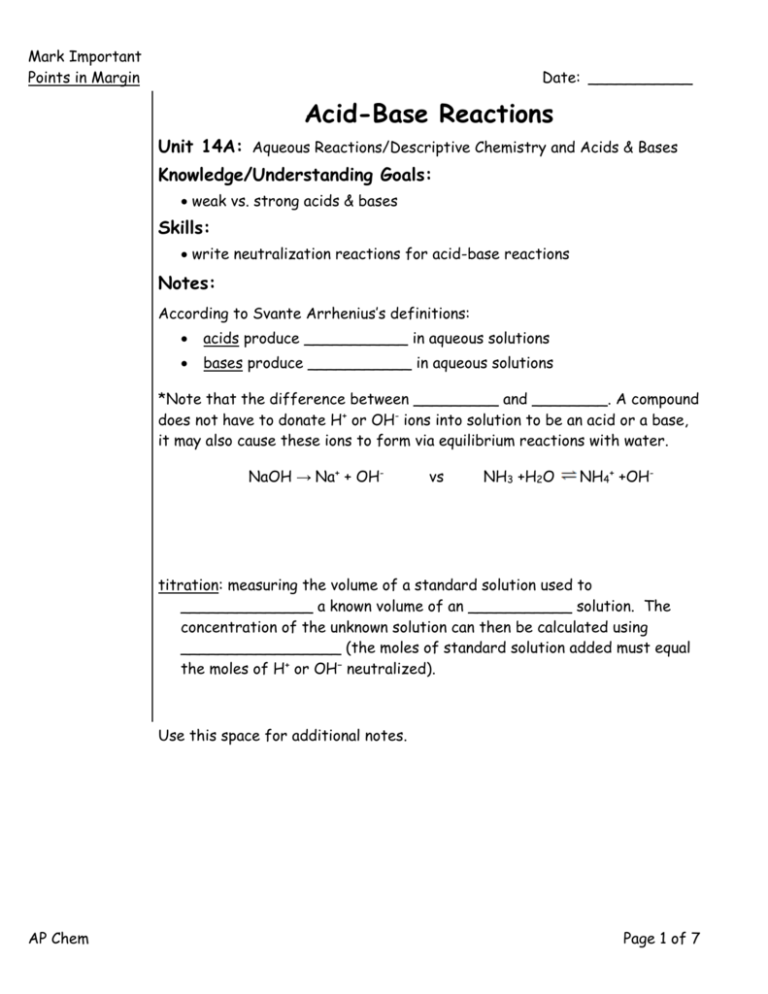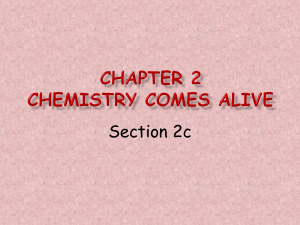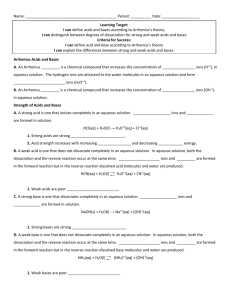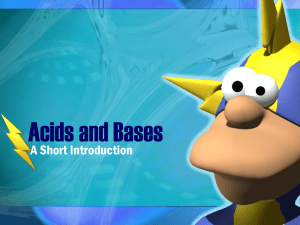Acid-Base Reactions - Mr. Walsh`s AP Chemistry
advertisement

Mark Important Points in Margin Date: ___________ Acid-Base Reactions Unit 14A: Aqueous Reactions/Descriptive Chemistry and Acids & Bases Knowledge/Understanding Goals: weak vs. strong acids & bases Skills: write neutralization reactions for acid-base reactions Notes: According to Svante Arrhenius’s definitions: acids produce ___________ in aqueous solutions bases produce ___________ in aqueous solutions *Note that the difference between _________ and ________. A compound does not have to donate H+ or OH- ions into solution to be an acid or a base, it may also cause these ions to form via equilibrium reactions with water. NaOH → Na+ + OH- vs NH3 +H2O NH4+ +OH- titration: measuring the volume of a standard solution used to ______________ a known volume of an ___________ solution. The concentration of the unknown solution can then be calculated using _________________ (the moles of standard solution added must equal the moles of H+ or OH− neutralized). Use this space for additional notes. AP Chem Page 1 of 7 Mark Important Points in Margin Acid-Base Reactions strong acid: an acid that ionizes _____________ in water. HCl (aq) → H+ (aq) + Cl− (aq) Any acid with a negative pKa value (see reference table in your textbook) is a strong acid. Memorize the following strong acids: weak acid: an acid that ionizes only ___________ in water. HF (aq) H+ (aq) + F− (aq) Assume that any acid you will see on the AP Chemistry exam is a weak acid unless it is one of the strong acids listed above. Use this space for additional notes. AP Chem Page 2 of 7 Mark Important Points in Margin Acid-Base Reactions strong base: a base that dissociates _____________ in water. NaOH (aq) → Na+ (aq) + OH− (aq) Any base whose conjugate acid has a pKa value greater than 14 is a strong base. All __________ oxides and hydroxides of group I and group II metals are strong bases. (Except that aqueous Mg(OH)2 acts like a weak base because its ______________ is so _____ that the concentration of OH− ions in solution is similar to that produced by a weak base.) weak base: a base that ionizes only ___________ in water. Weak bases react with H2O, creating the conjugate acid and OH−. NH3 (aq) + H2O (ℓ) NH4+ (aq) + OH− (aq) Assume that any base you see on the AP Chemistry exam is a weak base unless it is one of the strong bases listed above. Use this space for additional notes. AP Chem Page 3 of 7 Mark Important Points in Margin Acid-Base Reactions Ions in Solution Strong acids and bases are strong _______________, meaning that they ionize to produce a large number of ions in water, and the resulting solution is a good _________________ of electricity. Weak acids and bases ionize only partially. This often means that the resulting solution is a ________ electrolyte (poor conductor of electricity). However, note that if the weak acid or base is itself an ____, the solution will be a ___________ electrolyte regardless of the amount of dissociation of the acid or base. H2PO4- (aq) + H2O (l) HPO42- (aq) + H3O+(aq) Use this space for additional notes. AP Chem Page 4 of 7 Mark Important Acid-Base Reactions Points in Margin Note that the _____ produced by the dissociation of _________ acids and bases (e.g., Li+, Na+, K+, Ca2+, Sr2+, Ba2+, Cl−, Br−, I−, NO3−, ClO4−, SO4−) act as ___________________, because their conjugate acids & bases do not form in aqueous solution. (Dissociation heavily favored) Note, however, that anions whose conjugates are weak acids (e.g., F−, CH3COO−, CO32−, PO43−, etc.) are _________. Similarly, cations whose conjugates are weak bases (e.g., NH4+) are _________ in solution. Note also that cations whose hydroxides are ___________ are acidic in solution because they remove OH− from solution. Thus, salts formed from ______ acid or base reactions will influence the final pH of the solution. A salt that is comprised of an acidic cation (such as NH4+) and a spectator anion (such as Cl−) will be ________ in solution. A salt that is comprised of a spectator cation (such as Na+) and a basic anion (such as CO32−) will be ________ in solution. A cation resulting in an insoluble hydroxide salt will be ________ in solution. Use this space for additional notes. AP Chem Page 5 of 7 Mark Important Points in Margin Acid-Base Reactions Acid-Base Reactions Strong Acid/Strong Base Because strong acids hydrolyze completely in water, the net ionic reaction for any strong acid/strong base reaction is: If you write out the detailed ionic equation, you will see that all of the other ions are spectators, as in the following example: HNO3 (aq) + NaOH (aq) → NaNO3 (aq) + H2O (ℓ) Use this space for additional notes. AP Chem Page 6 of 7 Mark Important Points in Margin Acid-Base Reactions Weak Acid/Strong Base 1. Write the weak reaction (ionization of the weak acid) first. 2. Write the reaction for the H+ combining with OH− from the strong base to form H2O. 3. Combine the two reactions. 4. Cancel out H+ from both sides. For example, in the reaction between HF (weak acid) and NaOH (strong base): HF (aq) H+ (aq) + F− (aq) Strong Acid/Weak Base 1. Write the weak reaction (reaction of the weak base with water) first. 2. Write the reaction for the OH− combining with H+ from the strong acid to form H2O. 3. Combine the two reactions. 4. Cancel out OH− and H2O from both sides. For example, in the reaction between HCl (strong acid) and NH3 (weak base): NH3 (aq) + H2O (ℓ) NH4+ (aq) + OH− (aq) Use this space for additional notes. AP Chem Page 7 of 7








